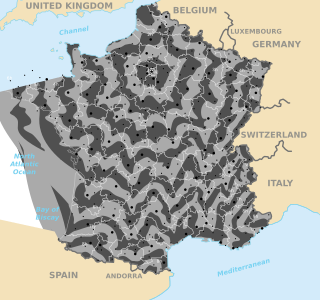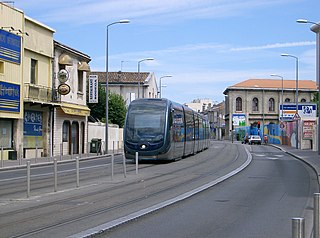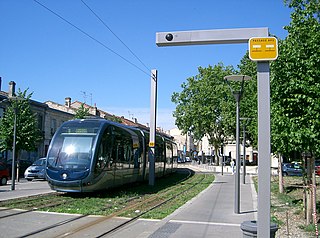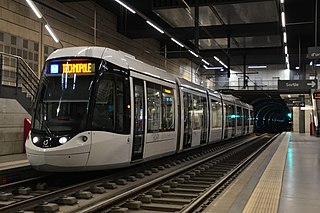
Transportation in France relies on one of the densest networks in the world with 146 km of road and 6.2 km of rail lines per 100 km2. It is built as a web with Paris at its center. Rail, road, air and water are all widely developed forms of transportation in France.

A third rail, also known as a live rail, electric rail or conductor rail, is a method of providing electric power to a railway locomotive or train, through a semi-continuous rigid conductor placed alongside or between the rails of a railway track. It is used typically in a mass transit or rapid transit system, which has alignments in its own corridors, fully or almost fully segregated from the outside environment. Third-rail systems are usually supplied from direct current electricity.

The Alstom Citadis is a family of low-floor trams and light rail vehicles built by Alstom. As of 2017, over 2,300 Citadis trams have been sold and 1,800 tramways are in revenue service throughout the world, with operations in all six inhabited continents. An evolution of Alstom's earlier TFS vehicle, most Citadis vehicles are made in Alstom's factories in La Rochelle, Reichshoffen and Valenciennes, France, and in Barcelona, Spain, and Annaba, Algeria.

Ground-level power supply, also known as surface current collection or, in French, alimentation par le sol, is a concept and group of technologies whereby electric vehicles collect electric power at ground level from individually-powered segments instead of the more common overhead lines. Ground-level power supply was developed for aesthetic reasons, to avoid the presence of overhead lines in city centres.

Conduit current collection is an obsolete system that was used by some electric tramways to pass current to streetcars via a "conduit", a small tunnel under the roadway. Modern systems fall under the term ground-level power supply.

Tramway track is used on tramways or light rail operations. Grooved rails are often used to provide a protective flangeway in the trackwork in city streets. Like standard rail tracks, tram tracks consist of two parallel steel rails.

The Bordeaux tramway network consists of four lines serving the city of Bordeaux in Nouvelle-Aquitaine in southwestern France. The system has a route length of 77.5 kilometres (48.2 mi), serving a total of 133 tram stops.

The Rouen tramway is a tramway/light rail network in the city of Rouen, Normandy, France. Construction began in 1991 and the network opened for service on 17 December 1994.
The stud contact system is an obsolete ground-level power supply system for electric trams. Power supply studs were set in the road at intervals and connected to a buried electric cable by switches operated by magnets on the tramcars. Current was collected from the studs by a "skate" or "ski collector" under the tramcar. The system was popular for a while in the early 1900s but soon fell out of favour because of the unreliability of the magnetic switches, largely due to friction and rapid corrosion affecting its cast iron moving components.

Reims tramway is a tram system in the French city of Reims, which opened in April 2011. It travels north to south, through the city, along 11.2 kilometres (7.0 mi) of route.

The Angers tramway is the tramway network in the French city of Angers in Pays de la Loire.

Trams in France date from 1837 when a 15 km steam tram line connected Montrond-les-Bains and Montbrison in the Loire. With the development of electric trams at the end of the 19th century, networks proliferated in French cities over a period of 15 years. Although nearly all of the country's tram systems were replaced by bus services in the 1930s or shortly after the Second World War, France is now in the forefront of the revival of tramways and light rail systems around the globe. Only tram lines in Lille and Saint-Étienne have operated continuously since the 19th century; the Marseille tramway system ran continuously until 2004 and only closed then for 3 years for extensive refurbishment into a modern tram network. Since the opening of the Nantes tramway in 1985, more than twenty towns and cities across France have built new tram lines. As of 2020, there are 29 operational tram networks in France, with 3 more planned. France is also home to Alstom, a leading tram manufacturer.

The Dubai Tram is a tramway located in Al Sufouh, Dubai, United Arab Emirates. It runs for 14.5 kilometers (9.0 mi) along Al Sufouh Road from Dubai Marina to the Palm Jumeirah and Al Sufouh. The tram connects with the DMCC and Sobha Realty stations of the Dubai Metro's Red Line, and two more stations are expected to connect with the tram in the future. The Dubai Tram is also connected with the monorail of the Palm Jumeirah at the entrance of the Palm from Sufouh Road.

The Mulhouse tramway is a tram network in the French city of Mulhouse in Alsace, France. It commenced service in 2006, and now comprises three purely tram lines, plus one hybrid tram-train line.

The Rabat–Salé tramway is a tram system in the Moroccan agglomeration of Rabat and Salé cities which opened on 23 May 2011.

Conductive charging is conductive power transfer that replaces the conductive wires between the charger and the charged device with conductive contacts. Charging infrastructure in the form of a board or rail delivers the power to a charging device equipped with an appropriate receiver, or pickup. When the infrastructure recognizes a valid receiver it powers on, and power is transferred.

Rio de Janeiro Light Rail is a modern light rail system serving Rio de Janeiro, Brazil. The system is among several new public transport developments in the region ahead of the city's successful bid for the 2016 Summer Olympics. Its official name is VLT Carioca, the initialism "VLT" being equivalent to the English term light rail.

Acumulador de Carga Rápida (ACR) is a battery electric tram system marketed by Construcciones y Auxiliar de Ferrocarriles (CAF) of Spain. Trams equipped with ACR are fast-charged while at stops; elsewhere they require no overhead line, which is desirable for reasons of safety, reliability, cost, and aesthetics. It also allows regenerative braking where direct current electrification systems cannot return (much) energy to the grid.
The Swedish Transport Administration electric road program or Swedish Transport Administration Electrification Program is a program involving the assessment, planning, and implementation of an electric road national infrastructure for Sweden by Trafikverket, the Swedish Transport Administration.




















